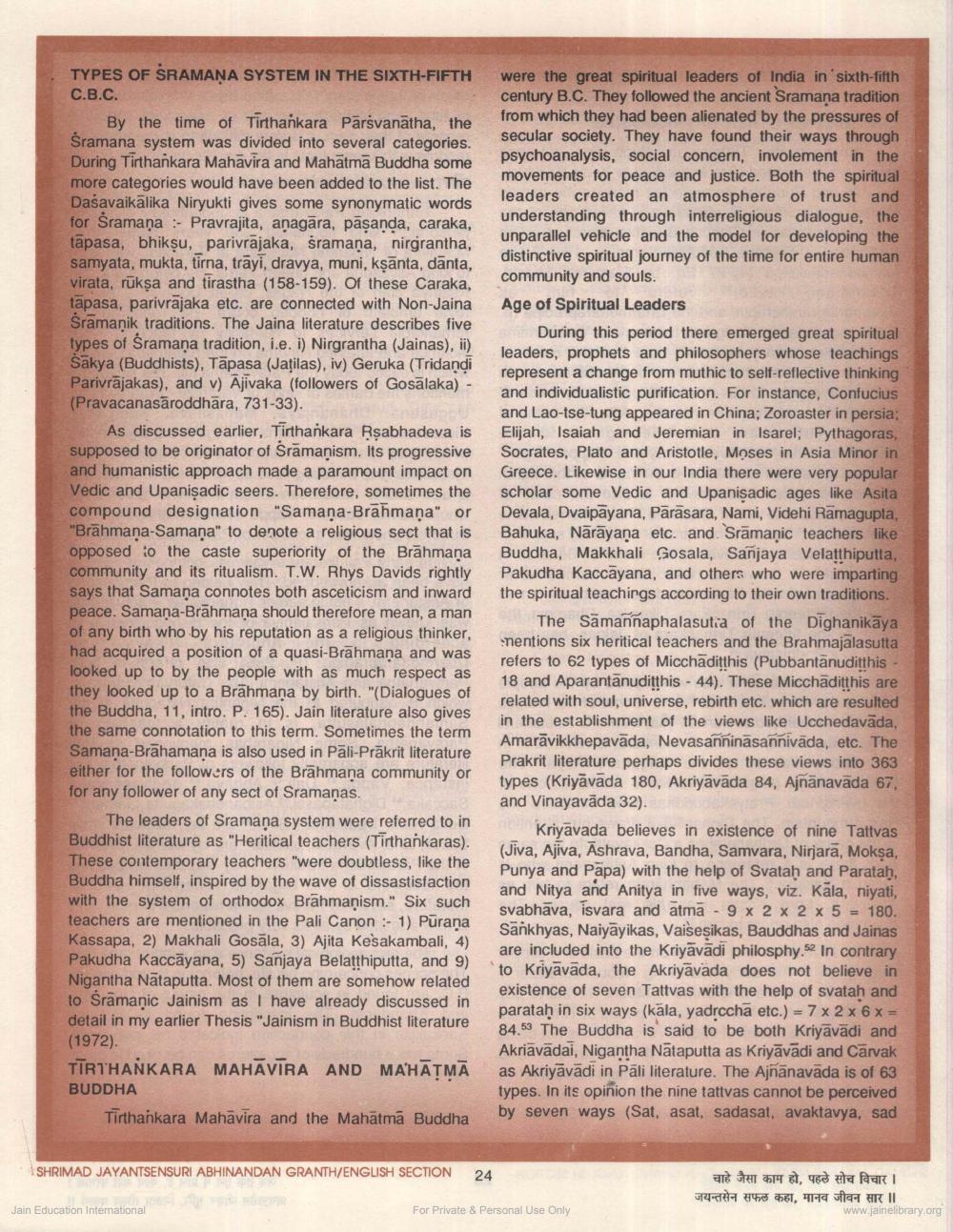________________
TYPES OF SRAMANA SYSTEM IN THE SIXTH-FIFTH C.B.C.
By the time of Tirthankara Pārsvanātha, the Sramana system was divided into several categories. During Tirthankara Mahavira and Mahātmā Buddha some more categories would have been added to the list. The Dasavaikalika Niryukti gives some synonymatic words for Sramana - Pravrajita, anagara, pasanda, caraka, tapasa, bhikṣu, parivrājaka, šramana, nirgrantha, samyata, mukta, tirna, trāyi, dravya, muni, kşānta, danta, virata, ruksa and tirastha (158-159). Of these Caraka, tapasa, parivrajaka etc. are connected with Non-Jaina Sramanik traditions. The Jaina literature describes five types of Sramaņa tradition, i.e. i) Nirgrantha (Jainas), ii) Sakya (Buddhists). Tāpasa (Jatilas), iv) Geruka (Tridandi Parivrājakas), and v) Ajivaka (followers of Gosālaka) - (Pravacanasāroddhāra, 731-33).
As discussed earlier, Tirthankara Rsabhadeva is supposed to be originator of Srāmanism. Its progressive and humanistic approach made a paramount impact on Vedic and Upanisadic seers. Therefore, sometimes the compound designation "Samana-Brahmana" or "Brāhmana-Samana" to denote a religious sect that is opposed to the caste superiority of the Brāhmana community and its ritualism. T.W. Rhys Davids rightly says that Samana connotes both asceticism and inward peace. Samana-Brāhmana should therefore mean, a man of any birth who by his reputation as a religious thinker, had acquired a position of a quasi-Brahmana and was looked up to by the people with as much respect as they looked up to a Brähmana by birth. "(Dialogues of the Buddha, 11, intro. P. 165). Jain literature also gives the same connotation to this term. Sometimes the term Samana-Brahamana is also used in Pāli-Prākrit literature either for the followers of the Brahmana community or for any follower of any sect of Sramaņas.
The leaders of Sramaņa system were referred to in Buddhist literature as "Heritical teachers (Tirthankaras). These contemporary teachers "were doubtless, like the Buddha himself, inspired by the wave of dissastisfaction with the system of orthodox Brahmanism." Six such teachers are mentioned in the Pali Canon :- 1) Purana Kassapa, 2) Makhali Gosāla, 3) Ajita Kesakambali, 4) Pakudha Kaccāyana, 5) Sanjaya Belatthiputta, and 9) Nigantha Nataputta. Most of them are somehow related to Sramanic Jainism as I have already discussed in detail in my earlier Thesis "Jainism in Buddhist literature (1972) TĪRTHANKARA MAHĀVĪRA AND MAHĀTMĀ BUDDHA
Tirthankara Mahavira and the Mahātmā Buddha
were the great spiritual leaders of India in sixth-fifth century B.C. They followed the ancient Sramana tradition from which they had been alienated by the pressures of secular society. They have found their ways through psychoanalysis, social concern, involement in the movements for peace and justice. Both the spiritual leaders created an atmosphere of trust and understanding through interreligious dialogue, the unparallel vehicle and the model for developing the distinctive spiritual journey of the time for entire human community and souls. Age of Spiritual Leaders
During this period there emerged great spiritual leaders, prophets and philosophers whose teachings represent a change from muthic to self-reflective thinking and individualistic purification. For instance, Confucius and Lao-tse-tung appeared in China; Zoroaster in persia; Elijah, Isaiah and Jeremian in Isarel; Pythagoras Socrates, Plato and Aristotle, Moses in Asia Minor in Greece. Likewise in our India there were very popular scholar some Vedic and Upanisadic ages like Asila Devala, Dvaipāyana, Pārāsara, Nami, Videhi Ramagupta. Bahuka, Nārāyana etc. and Srāmanic teachers like Buddha, Makkhali Gosala, Sanjaya Velatthiputta, Pakudha Kaccäyana, and others who were imparting the spiritual teachings according to their own traditions.
The Sämannaphalasutia of the Dighanikāya mentions six heritical teachers and the Brahmajalasutta refers to 62 types of Micchaditthis (Pubbantanuditthis 18 and Aparantanuditthis - 44). These Micchaditthis are related with soul, universe, rebirth etc. which are resulted in the establishment of the views like Ucchedavada, Amarāvikkhepavāda, Nevasanninäsannivada, etc. The Prakrit literature perhaps divides these views into 363 types (Kriyāvada 180, Akriyāvāda 84, Ajnänavāda 67, and Vinayavāda 32).
Kriyāvada believes in existence of nine Tattvas (Jiva, Ajiva, Ashrava, Bandha, Samvara, Nirjara, Moksa, Punya and Papa) with the help of Svatan and Paratan, and Nitya and Anitya in five ways, viz. Kāla, niyati, svabhāva, isvara and atma - 9 x 2 x 2 x 5 = 180. Sankhyas, Naiyāyikas, Vaisesikas, Bauddhas and Jainas are included into the Kriyāvādi philosphy.52 In contrary to Kriyavāda, the Akriyāvada does not believe in existence of seven Tattvas with the help of svatah and paratah in six ways (kāla, yadrccha etc.) = 7x 2 x 6 x = 84.53 The Buddha is said to be both Kriyavadi and Akriāvādai, Nigantha Nātaputta as Kriyāvādi and Cārvak as Akriyāvadi in Pāli literature. The Ajnänavada is of 63 types. In its opinion the nine tattvas cannot be perceived by seven ways (Sat, asat, sadasat. avaktavya, sad
Kri
SHRIMAD JAYANTSENSURI ABHINANDAN GRANTH/ENGLISH SECTION
24
चाहे जैसा काम हो, पहले सोच विचार । जयन्तसेन सफल कहा, मानव जीवन सार ।।
www jainelibrary.org
Jain Education International
For Private & Personal Use Only




